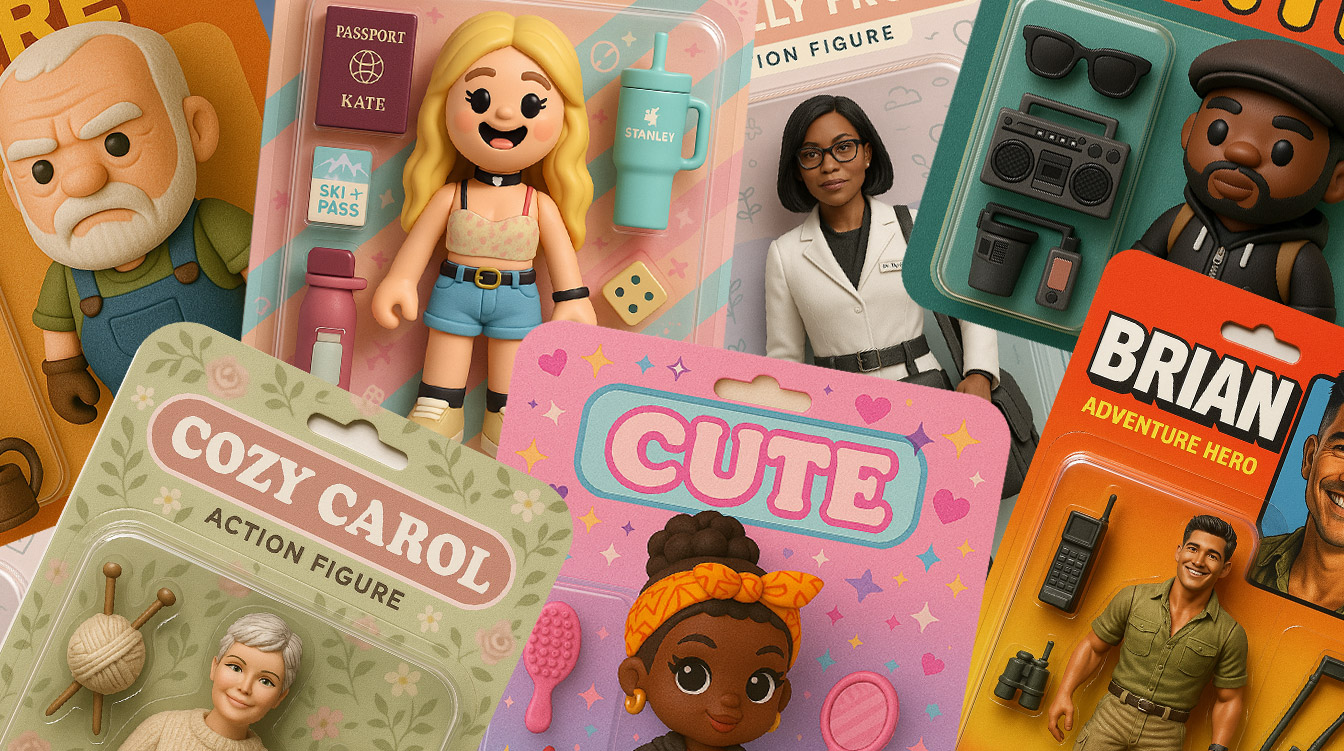
Is posting AI art worth the backlash? A guide for brands
Summary
AI-generated image trends like action figure portraits and Studio Ghibli-style art are going viral. But many brands that jump on the trend face backlash from artists and consumers. This article explains why, and how social listening and sentiment analysis can help brands navigate wisely.
Why are AI image trends creating controversy?
There’s a new wave of AI-generated images sweeping social media. In one trend, users turn themselves into action figure-style portraits, complete with plastic blister packs and accessories. Searches for “how to do the Barbie Box trend” have spiked by 2,600%. In another, they reimagine themselves in the whimsical world of the Japanese anime legends Studio Ghibli, with floating cherry blossoms and pastel skies. These have spread quickly across social media in the UK, US and beyond — they’re easy to create and essentially free, and the results are cute, funny and shareable. Understandably, many brands are eager to take part.
But the response isn’t always positive.
Designers, illustrators, and users have criticised these trends as exploitative and inauthentic. Comments range from disappointment to outright scorn. Posts from brands have been edited or deleted after negative feedback, often triggered by accusations of laziness or disrespect for human creatives. On Reddit, for example, a massive discussion in r/movies branded the Studio Ghibli AI trend “an utter insult” to the studio and anime as an art form, garnering 35,000 upvotes and thousands of comments in agreement.
What’s behind the backlash?
Why are creatives so critical of AI art trends?
Criticism has been strongest among the creative community. The Ghibli-style trend has faced accusations of artistic theft, with many arguing it uses the recognisable style of Ghibli co-founder Hayao Miyazaki and his fellow artists without consent.
In a widely shared quote from an interview in 2016, Miyazaki called AI animation "an insult to life itself". That statement resurfaced as the Ghibli meme went viral.
Illustrator Karla Ortiz was more direct: "That’s using Ghibli’s branding, their name, their work, their reputation, to promote OpenAI products… It’s exploitation."
For artists themselves, the rise of AI trends are serious, and literally existential. AI art threatens livelihoods, particularly for commercial illustrators, and undermines industries that depend on human creativity.
What happens when brands get it wrong?
There are plenty of examples of brands that have stumbled:
- Michaels Crafts, a US craft retailer, posted AI-generated crocheted dolls and deleted the post after backlash from its artist community.
- Even the White House was caught up, posting a “Ghiblified” image to depict a real arrest. Critics called it "ghastly" and tone-deaf. The post, however, is still up.
In each case, brands misjudged the tone and faced reputational damage.
What about environmental concerns?
Criticism isn’t just artistic. There’s a growing concern about the sustainability of AI. Generating images at scale requires energy-hungry servers and GPUs. UK tech entrepreneur Mel Morris said: "The LinkedIn action figure trend and its demand on GPUs is obviously unsustainable."
For brands with eco-credentials, using AI art can seem hypocritical.
Do consumers actually trust AI-generated content?
Yes – but only if it’s authentic, transparent, and appropriate.
- A Getty Images survey (2024) found that 98% of consumers value authenticity in brand visuals.
- Nearly 9 in 10 want to know when an image has been AI-generated.
- NielsenIQ found AI visuals were more likely to be described as "boring," "confusing," or "annoying" compared to traditional imagery.
In short, AI images can erode trust if used without context.
What should brands do instead?
How can brands join trends without backlash?
Use a clear decision framework:
- Listen first: Use social listening and sentiment analysis to understand your audience's mood. We can help you with this — it’s what we do.
- Evaluate alignment: Does the trend fit your values and tone? If not, don't force it.
- Be transparent: Label AI imagery clearly. Acknowledge the inspiration or origin.
- Support human creatives: Commission a real artist instead. It builds credibility.
When Is It Better to Sit a Trend Out?
When:
- The trend undermines your brand values
- Your audience is vocal about disliking it
- It feels opportunistic rather than authentic
Not posting can often do more for your brand than a viral gimmick that lands badly.
FAQs
Why are people angry about AI-generated Ghibli images?
Because the style directly imitates the work of Studio Ghibli and Hayao Miyazaki without permission. Many view it as artistic theft.
Are AI-generated images bad for the environment?
Yes, they consume large amounts of computing power and energy, which contributes to carbon emissions.
Should brands use AI art?
Not necessarily. It depends on the audience, context, and alignment with brand values. Transparency is key.
Can AI art trends help engagement?
Sometimes. But trends that attract short-term attention can backfire if sentiment is negative.
Final thought
AI art trends won’t stop anytime soon. But that doesn’t mean brands should join them blindly.
Smart brands will watch, listen, and weigh the risks before they post. Engagement matters. But so does trust.
To talk to us about learning what your audience will respond to drop us a line today.
Marc Burrows Published on May 8, 2025 9:20 am

